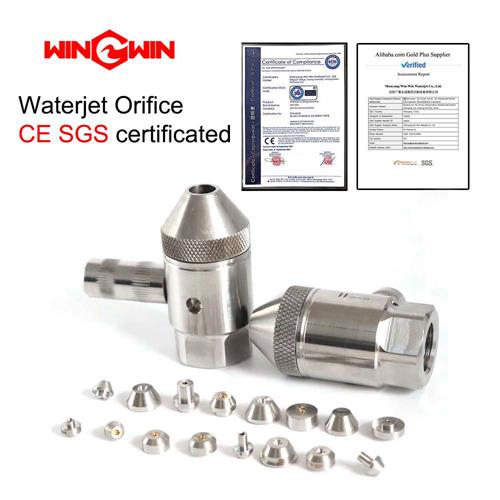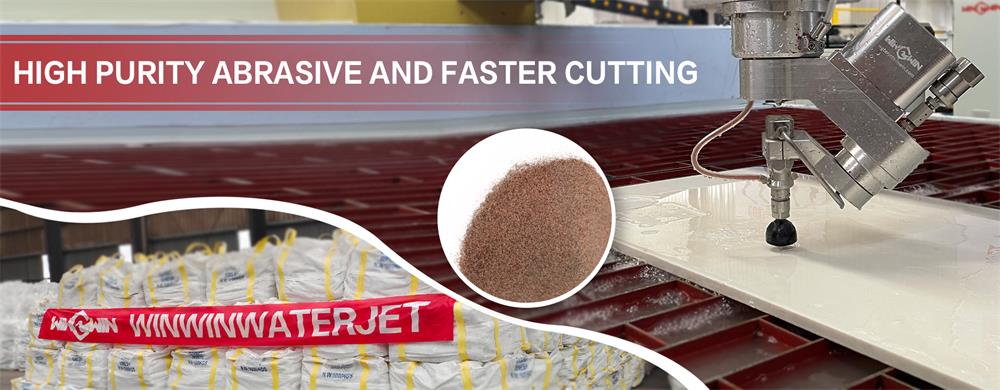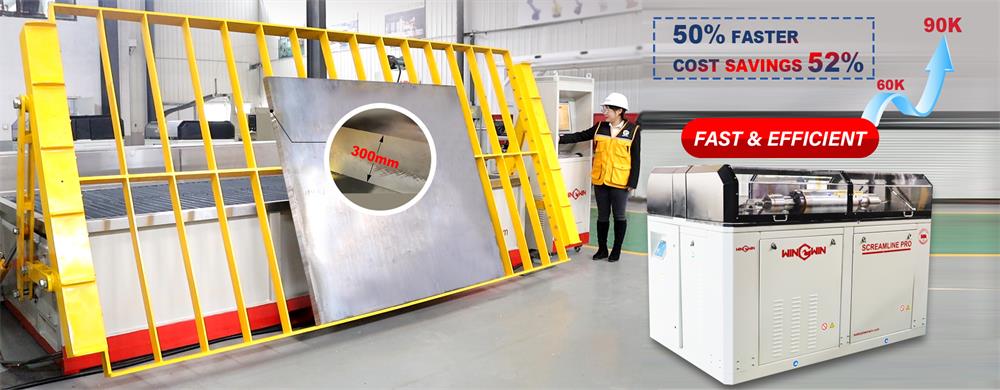Like any machine, water jet cutting systems can experience problems or issues that can impact their performance and efficiency. water jet cutting systems can experience a range of problems and issues, including nozzle clogging, pump failure, high operating costs, material waste, environmental impact, maintenance and repair, and safety concerns. However, many of these problems can be prevented or minimized through proper maintenance, monitoring, training, and optimization of the cutting process. It is important to carefully consider these factors when selecting a water jet cutting system and implementing it in an industrial or manufacturing setting.Here are some problems occur with water jet cutting machines.

Orifice Nozzle clogging: Over time, the nozzle of the water jet cutting system can become clogged with debris or abrasive particles, reducing cutting efficiency and accuracy. Regular cleaning and maintenance of the nozzle can help to prevent this problem. The orific is the part of the machine that help the water and abrasive stream for the material being cut. time goes by, the orifice can become damaged, leading to a failure in cutting accuracy and efficiency.The waterjet orifice is a small, precision component that controls the flow of water and abrasive material in a waterjet cutting machine. It is a critical part of the cutting process, and any problems with the orifice can result in reduced cutting quality and efficiency. Some common issues that can arise with the waterjet orifice include:
Wear and tear: The waterjet orifice is subject to wear and tear over time, particularly if it is made from a softer material like ruby or sapphire. This can result in a decrease in cutting power and accuracy, and may require the orifice to be replaced.
Clogging: The orifice can become clogged with debris or abrasive material, which can reduce the flow of water and abrasive material and cause poor cutting quality. Regular cleaning and maintenance can help prevent clogging.
Improper alignment: The orifice must be properly aligned with the mixing chamber and nozzle to ensure optimal cutting performance. If it is not aligned properly, it can cause poor cutting quality and increased wear and tear on the orifice and other components.
Cracks or damage: The orifice can become damaged becasue impact or wear and tear. This can lead to reduced cutting power and accuracy and may require the orifice to be replaced. Improper size: The size of the orifice must be appropriate for the cutting application to ensure optimal cutting performance. If the orifice is too small, it can cause reduced cutting powerand efficiency, while if it is too large, it can cause excessive wear and tear on the machine.
Pump failure: The high-pressure pump is a critical component of the water jet cutting system, and pump failure can lead to reduced cutting power or complete system shutdown. Regular maintenance and monitoring of the pump can help to prevent this problem. The HP pump is working for generating the water pressure needed to power the cutting process. Problems with the pump can lead to insufficient pressure, which can result in slower cutting speeds or even a complete halt in the cutting process.A high-pressure pump is a critical component in a waterjet cutting machine, and it can encounter several problems that can impact the machine's performance. Some of the most common problem that can occur with a waterjet high-pressure pump include:
Loss of pressure: A decrease in water pressure is a common problem with high-pressure pumps, and it can be caused by various factors such as leaks, worn seals, or a damaged piston. This can lead to slower cutting speeds, reduced cutting power, or even a complete stop in the cutting process. Overheating: High-pressure pumps generate a lot of heat during operation, and if the cooling system fails or is inadequate, the pump can overheat. This can cause damage to the pump components and may result in a complete shutdown of the machine.
Cavitation: Cavitation is the formation of bubbles in the water due to a drop in pressure. These bubbles can harm the pump's internal components, leading to reduced performance and eventual failure. Noisy operation: High-pressure pumps can produce a lot of noise during operation, but excessive noise can be a sign of a problem. This may be caused by worn bearings or other components, which can lead to increased friction and reduced efficiency.
Leakage: water-Leaks in the pump's seals or valves can result in a loss of pressure and reduced cutting power. This can also casue water damage to other components of the machine. Operating cost: Water jet cutting systems can be expensive to operate, with high electricity and water consumption costs.

Abrasive delivery system: If the waterjet cutting machine uses abrasive materials, the delivery system that feeds the abrasive into the water stream can become clogged or malfunction, causing disruptions in the cutting process.The abrasive delivery system in a waterjet cutting machine delivers the abrasive material into the water stream, which is used to cut through the workpiece. Some common issues that can arise with the abrasive delivery system include:
Clogging: Abrasive material can easily clog the delivery system, particularly if the abrasive is not properly screened or if the delivery hose is too small. This can result in a reduction in cutting power and accuracy, or a complete stop in the cutting process.
Abrasive flow problems: The abrasive flow rate must be consistent and accurate for optimal cutting performance. If the flow is too slow or inconsistent, it can lead to poor cutting quality, and if it is too fast, it can cause damage to the machine.
Abrasive contamination: If the abrasive material is contaminated with dust or debris, it can cause blockages in the delivery system or interfere with the cutting process. finanly lead to poor cutting quality and increased wear and tear on cutter components. Hose wear and tear: The abrasive material can cause wear and tear on the delivery hose over time, which can lead to leaks and loss of pressure. This can result in reduced cutting power and accuracy.
Improper mixing: The abrasive material must be properly mixed with the water to ensure consistent cutting performance. If the mixture is incorrect, it can lead to poor cutting quality, reduced cutting power, or damage to the machine.
Regular maintenance and inspection of the abrasive delivery system can help prevent these issuesand ensure that the waterjet cutting machine operates smoothly. It is important to follow the manufacturer's guidelines for maintenance, use high-quality abrasive material, and properly screen the abrasive to prevent clogging. Additionally, it is important to regularly inspect the delivery hose and any other components of the system to ensure that they are in good condition and replace them as needed.
Water filtration system: Waterjet cutting machines rely on a constant supply of clean water to operate effectively. If the water filtration system becomes clogged or malfunctions, the water quality may be compromised, leading to problems with the cutting process.The water filtration system is a critical component of a waterjet cutting machine because it ensures a constant supply of clean water is available for the cutting process. Some common issues that can arise with the water filtration system include:
Clogging: The filtration system can become clogged with debris or sediment, which can reduce the flow of water and lead to poor cutting quality. Regular cleaning and maintenance can help prevent clogging. Filter wear and tear: The filters in the water filtration system can become worn and lose their effectiveness over time. which end to poor water quality and reduced cutting performance.
Improper installation: If the water filtration system is not installed correctly or if the filters are not properly aligned, it can cause reduced water flow and poor cutting quality. Water quality issues: The water quality can affect the cutting performance of the waterjet cutting machine. If the water contains high levels of minerals or other contaminants, it can cause reduced cutting power and accuracy. Pump damage: If the water filtration system fails, it can cause damage to the pump and other components of the waterjet cutting machine. This can result in costly repairs and downtime.

Also some other problems need to be aware:
Material waste: Water jet cutting can produce a significant amount of material waste, particularly when cutting complex shapes or intricate designs. Optimizing the cutting process and minimizing waste can help to reduce material costs and improve efficiency. Environmental effect: Water jet cutting can have a significant environmental problem, particularly due to the high water consumption and the potential for waste-water contamination. Proper disposal and treatment of water and garnet can help to reduce the environmental impact of the system.
Maintenance and repair: Regular maintenance and repair of the water jet cutting system are critical to ensuring optimal performance and longevity of the system. Proper training and maintenance procedures can help toprevent downtime and reduce repair costs.
Safety: Water jet cutting systems operate at high pressures and can pose a safety risk to operators if not used properly. Proper safety procedures and training are essential to prevent accidents and injuries.
Controller: The controller is responsible for managing the various components of the machine and ensuring that they are working together properly. Malfunctions in the controller can cause issues with the cutting process and may require technical expertise to resolve.
 wwaterjet
wwaterjet